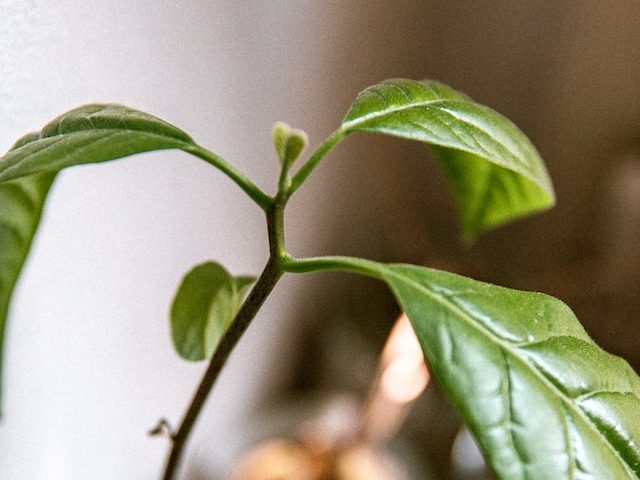Avocado Tree

First things first, don’t panic. Brown leaves on your Avocado Tree are a common issue and can be due to various causes, some serious and others easy to fix.
From necessary nutritional deficiencies, to pesky pests, to favorable weather conditions, many factors can provoke brown leaves. Below we will walk you through these causes and remedies, so you’ll be equipped to revive your Avocado Treee back to normal in no time.
Contents
Common Causes of Brown Leaves on Avocado Trees
So, what’s actually causing your Avocado tree’s leaves to turn brown, and how can you find out? Several factors could be at play, and it’s crucial to identify them right to target the problem accurately.
Overwatering or Underwatering
Yes, avocado trees love moisture, but too much or too little of it can cause your leaves to turn brown. Overwatering disrupts the oxygen levels, drowning the roots, while underwatering-starves the roots, causing dehydration.
The hydration balance is, therefore, key to maintaining a healthy Avocado Tree and brown leaves can quickly develop if something isn’t right.
Nutrient Deficiency
The lack of certain nutrients may also lead to your Avocado Tree’s leaves turning brown. For instance, a deficiency of Zinc or Manganese can cause leaf discoloration.
Similarly, inadequate iron supply can lead to iron chlorosis, a condition that causes leaves to turn yellow or brown.
Temperature Stress
Frost damage during cold winters or scorching during hot summer seasons can cause the leaves to brown. Always ensure to provide your tree with a suitable environment, especially if you live in extreme weather conditions.
While temperature stress won’t cause brown leaves from one day to the next, over time it can cause some serious issues if not treated.
Pests or Disease
Watch out for pests and diseases as these can cause a whole range of different issues not just brown leaves.
Some common culprits include the avocado lace bug and root rot disease. The former causes brown, necrotic spots on leaves, while the latter affects the roots and can eventually lead to brown leaves.
Salt Accumulation
Finally, excessive salts in the soil might be the cause. High salt levels can prevent the roots from absorbing water efficiently, leading to dehydration and brown leaves. This often happens when the same water source (rich in salts) is used over time without leaching.
Treating Brown Avocado Tree Leaves
A good place to start is by pinpointing the cause of the browning. Once you know the reason, treatment becomes more straightforward and more successful.
When it’s an issue of drought stress, react quickly. At this point, a deep watering treatment is your best friend. Water your Avocado Tree thoroughly until you’re sure the soil is completely damp. However, remember that overwatering can also be stressful and damaging for your Avocado Tree so it’s about finding that perfect balance.
If salt build-up is causing leaf burn, you’ll need to take a different approach. Flushing the soil to remove excess salts should be the first step. Simply use plenty of water, then wait for the water to drain. It’s something you can do on your own, without the need for professional help.
If you’ve spotted pests (or signs of them) the solution could be as simple as spraying your tree with a gentle water stream to dislodge pests. This will work well if the pest infestation is quite new.
Using natural pest deterrents, or in worse case scenarios, organic pesticides, can help keep your tree’s leaves safe and sound.
If the issue is more severe, then you may need to remove large sections from your plant and consider getting rid of it if things don’t improve, to remove any risk of the pests spreading to your other plants.
If the cause is sunburn, provide shade to protect those delicate leaves from too much direct sun exposure. You could do something as simple as constructing a shade cloth over your tree.
And in the case of cold damage, protective covers and wraps could help or move it to a slightly warmer area of your home. A digital thermometer can help with this.
For those where nutrient deficiency is the problem, worry not. Feeding your tree the correct, balanced nutrients essential for its growth might be all you need.
If you’re not super confident with adding fertilizer, then swapping half of the potting mix out for new fresh mix is a great way to replenish the nutrient levels.
Finally, we have disease. In this case, treatment options might be more specific and dependent on the type of disease.
Often, using a fungicide can help to combat leaf spot diseases, while bacterial diseases may require additional care.
Removing Brown Leaves from your Avocado Tree
It’s important to start with saying that once part of your Avocado Tree has turned brown, there is no going back. These leaf cells have died and there’s nothing you can do to save that bit of leaf.
While we do recommend removing leaves that have over 50% brown cells, we recommend keeping any leaves with just a few brown spots (unless pests is the issue – there you need to take a different approach based on where the pests have spread to).
A few brown spots and patches here and there can still mean that leaf is valuable for photosynthesis so don’t remove every leaf that just has a few brown spots, or brown tips.
- Inspect the tree: Before you start the pruning process, have a thorough look at the tree. Which leaves are brown? Are there any patterns? This step not only helps you identify which leaves need to go but also further assess the general health of your tree.
- Prepare your tools: All you will need is a pair of sharp, clean pruning shears or scissors as dirty tools can introduce bacteria and other pathogens to your tree. A quick wipe with rubbing alcohol should be enough to ensure they are sterile.
- Prune the knowing: Starting from the bottom and working your way up, gently remove the very browned out leaves. Be careful not to strip too many leaves at once – leave enough green leaves for photosynthesis.
A widespread problem may require a more drastic approach. If about half the tree’s leaves are brown, it may be best to remove the entire tree and replace it with a healthy one.
Always ensure to remove the affected tree and surrounding soil to prevent any possible disease or pest spread to the new tree.
Preventing Brown Leaves: Best Practices for Avocado Tree Care
Providing your tree with the right amount of water is key. Too little can lead to a dried out and shrivelled root system, while too much can lead to root rot. Depending on the size and age of the tree, 1 to 1.5 inches of water per week is generally sufficient.
It’s always a good idea to check the soil moisture before watering. If the top inch is dry, it’s time to water.
Ensuring proper nutrition is another key aspect. Apply a balanced slow-release fertilizer specifically designed for citrus and avocado trees. Usually, you should fertilize your avocado tree once in the spring and again in the fall.
Sunlight and shade are equally important for your Avocado Tree. Your tree needs at least 6 hours of sunlight daily. But, intense, direct sunlight can cause sunburn. So, if you live in a hot climate, protect your tree by using a shade cloth during the peak hours of the day.
As for pruning, it’s best to maintain a regular pruning schedule to remove dead or diseased branches and encourage new growth. But be modest in your cuts – pruning too much at one time can stress the tree.
Natural Remedies for Treating Brown Leaves on Avocado Trees
Compost Tea & Mulch: Compost tea, a rich, organic “brew” made up of compost, is like a power-packed superfood for your avocado tree. It can provide the necessary nutrients your tree needs and enhances its overall health.
Mulching is another beneficial practice. Mulch also helps retain moisture, suppresses weeds, and keeps soil temperature stable.
Trimming: Sometimes, the best remedy is preventive care. Make it a habit to regularly prune your avocado trees, removing any dead branches or leaves that could inhibit growth. This can make a big difference in halting the progression of leaf browning before it even starts.
Natural Pesticides: Ditch the chemicals and try a natural solution. Some common household items like vinegar, dish soap, or garlic can be potent organic pesticides. For example, a mixture of vinegar and water can serve as an effective deterrent for pests.
Here’s a simple natural pesticide recipe to get you started:
Combine 1 part white vinegar to 1 part water.
Add a few drops of dish soap (to help the solution stick to plants) and pour the mixture into a spray bottle.
Spray the solution liberally on the leaves of your avocado tree, focusing on areas where pest activity is noticeable.
Note: Ensure to spray in the morning or late evening to avoid sun scorch.
Frequently Asked Questions
Is it normal for Avocado Tree leaves to turn brown?
While a certain amount of leaf browning is normal, especially in older leaves or under stress conditions, persistent or widespread browning can signify an underlying problem, such as poor watering, lack of nutrients, diseases, or pest infestation.
Make sure you are keeping an eye on the rate at which the leaves are browning. If more new healthy leaves are growing out of the top of your tree, than are browning at the bottom, then this suggests the issue is simply natural ageing.
If your Avocado Tree isn’t growing many new leaves, and there are brown patches developing across the entire tree (not just at the bottom), then this does suggest a more serious issue.
If a few avocado tree leaves are browning, should I be worried?
Not necessarily. It’s common for a few leaves to brown naturally, especially if they’re older. However, if the browning is occurring regularly or across a lot of leaves, you might want to investigate further.
Where you don’t need to worry so much is if it’s the lower leaves that are turning brown. This is usually a sign of natural ageing. Monitor the rate of browning and watch out for any other warning signs that suggest the issue is more serious.
How can I prevent my avocado tree leaves from turning brown?
Regular watering, maintaining soil quality, ensuring good lighting, and protecting against pests and diseases are key to preventing brown spots, patches and leaves on your Avocado Tree.
Monitoring and promptly addressing any changes in leaf coloration can also help to prevent or limit leaf browning.
Are brown leaves a sign of a dying avocado tree?
Brown leaves may indicate a stressed or unhealthy tree, but not necessarily a dying one. Immediate and appropriate care can often restore tree health and prevent serious damage or death.
It’s also important to note that as your Avocado Tree ages, it’s normal for the odd older leaf to fall off. These leaves will tend to turn brown or yellow before they fall off the tree but it can be nothing to worry about.














